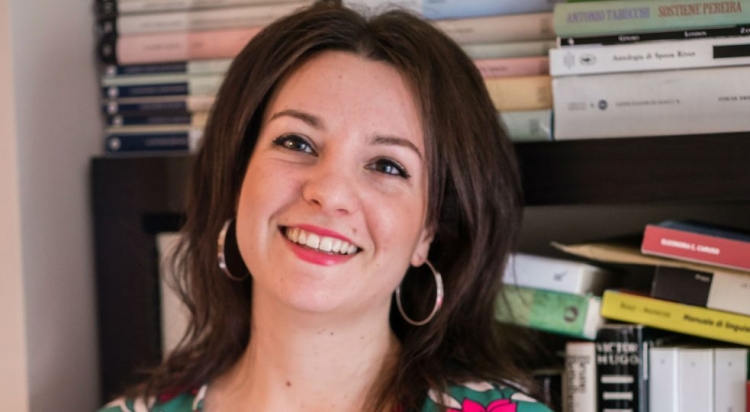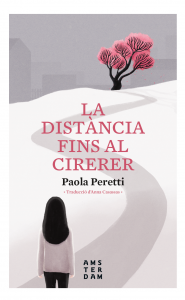Paola Peretti (The Distance Between Me and the Cherry Tree): “Stargardt’s disease toughened me, like anyone else who chooses not to give up. We need to be happy today and not worry too much about tomorrow”

Paola Peretti’s literary debut is the novel “The Distance Between Me and the Cherry Tree”, which is inspired by her Stargardt’s disease and is full of sensitivity, tenderness and courage
Mafalda is nine years old and is certain about just one thing: in six months she will completely lose her sight due to the Stargardt’s disease that she has. The distance at which she can see the cherry tree next to her school is how she measures her vision loss. With each day that passes, she has to get closer to bring the tree into focus. So she writes in a notebook all the things she would like to do before it gets too late: count the stars that light up the night, play football and climb the cherry tree.
Paola Peretti, who suffers from Stargardt’s disease, tells Mafalda’s story in “The Distance Between Me and the Cherry Tree”, which takes its inspiration from the Italian writer. Mafalda also suffers from Stargardt’s disease, and in the book she faces up to the difficulties caused by the pathology with fortitude and imagination. This is a novel that is full of sensitivity, tenderness and courage, a hymn to life that has won the hearts of readers and critics all around the world.
This is Paola Peretti’s literary debut. She has spoken to the Barcelona Macula Foundation about her novel and her condition.
What led you to write this book?
I wrote the book at a very difficult time in my life, a profound crisis. I had nothing to lose, I had problems with my precarious work, my family … and my vision. So I said to myself: “You wanted to be a writer. This is the perfect day to make a change!”
What is the novel about: loss, how to cope with problems, the complexity of existence, friendship and love?
All of them. But in writing it I was just telling a story. I think that’s the magic of writing: a girl like Mafalda can talk about loss, love, resilience, fear, human nature and diversity in a simpler way. I also hope the book brings readers a message of hope and acceptance.
How and when did you find out that you had Stargardt’s disease?
I can’t remember the exact date. I know I wasn’t a little girl, but nor was I an adult. The Stargardt’s disease is a rare one, which explains why the doctors thought I was only myopic: I couldn’t read the board. It took a few years for me to be diagnosed correctly.
¿How much of you is there in the character of Mafalda?
My soul is in Mafalda. I believe that, in the face of difficulties, we return to childhood, all of us. Out of fear, perhaps. And that’s one of the main things I share with Mafalda: fear. But she is also a tough girl, and I think she toughened me, like anyone else who chooses not to give up.
What gave you the idea of explaining Stargardt’s disease by having Mafalda narrate the steps she needs to see the cherry tree properly?
This is what I was used to doing. I lived alone at the time, and usually visited my parents twice a week. They had three big trees in their garden: when I reached the neighbourhood I saw the colours of the trees and I realised that I could only do it from a certain distance.
What is the idea behind your referencing of Cosimo, the protagonist of Italo Calvino’s novel ‘The Baron in the Trees’?
Cosimo is a rebellious character, a youngster who has no desire to obey the rules imposed by adults and society. Mafalda is afraid and this gives her courage: imitating this free, alternative behaviour is a source of inspiration for her. Both of them, Mafalda and Cosimo, experience a situation of discomfort and evolution. Calvino’s novel is also a really important book for her: by taking inspiration from it, Mafalda also pays tribute to her father and grandmother, who made her aware of the book.
Your book’s tone has been described as “fearless” and “frightening”. Do you agree?
Yes, I do. It’s frightening to read a book about a girl who has problems: we’re always trying to fool ourselves that we’re in control of everything, that nothing bad will happen to us. That’s not my philosophy. I’m aware that I can’t control the future, and that is frightening. I couldn’t help infusing Mafalda’s voice with it, but I hope too that she also appears fearless and tough.
How has the disease affected your day-to-day and professional life?
I taught Italian to foreign children for seven years. I can’t do that now because I can’t read my students’ homework properly and I’m not sure whether I could keep watch over them either. Ever since I was a student I had trouble travelling by bus from my home to school and reading textbooks. I used magnifying glasses to help me study. Of course, I now face a lot of problems, when reading documents, when moving … but I believe that by seeking out alternatives we can do everything we want.
How are you at the moment with regard to your sight?
I now have problems reading, going from my house to where I am visiting friends, promoting the book … I can’t watch a subtitled movie or count the stars in the sky. I’ve learned to accept it.
Before the book, did Stargardt’s sufferers contact you? What did they say?
Before the book, I tried to get in touch with people with my illness. But I could never do it. Stargardt’s disease is a strange disease because it seems as if we are “normal” people and it’s hard for us to accept our condition. We feel ashamed. So nobody contacted me before the book. Now they do, as do other people with different problems who write to me. They say “thank you,” and “I understand you.” It’s really moving.
What is your advice for those who suffer from Stargardt’s disease?
My advice is try to be happy today, without worrying too much about tomorrow, and do now the things you have wanted to do all your life. I usually remember my “little girl’s soul” and ask her if she is living life as she imagined. This might also be good advice for anyone.
